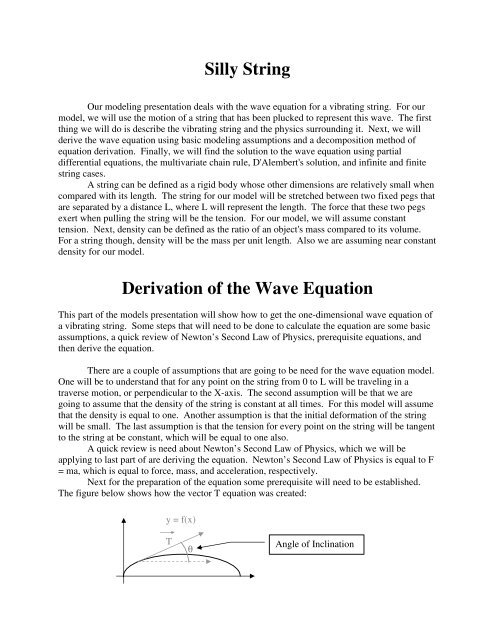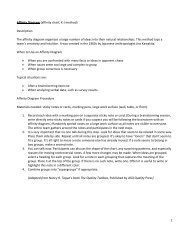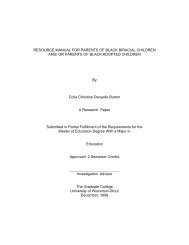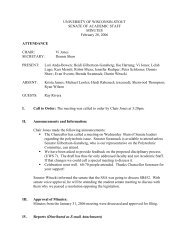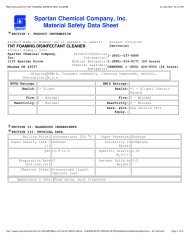Silly String Derivation of the Wave Equation
Silly String Derivation of the Wave Equation
Silly String Derivation of the Wave Equation
You also want an ePaper? Increase the reach of your titles
YUMPU automatically turns print PDFs into web optimized ePapers that Google loves.
<strong>Silly</strong> <strong>String</strong>Our modeling presentation deals with <strong>the</strong> wave equation for a vibrating string. For ourmodel, we will use <strong>the</strong> motion <strong>of</strong> a string that has been plucked to represent this wave. The firstthing we will do is describe <strong>the</strong> vibrating string and <strong>the</strong> physics surrounding it. Next, we willderive <strong>the</strong> wave equation using basic modeling assumptions and a decomposition method <strong>of</strong>equation derivation. Finally, we will find <strong>the</strong> solution to <strong>the</strong> wave equation using partialdifferential equations, <strong>the</strong> multivariate chain rule, D'Alembert's solution, and infinite and finitestring cases.A string can be defined as a rigid body whose o<strong>the</strong>r dimensions are relatively small whencompared with its length. The string for our model will be stretched between two fixed pegs thatare separated by a distance L, where L will represent <strong>the</strong> length. The force that <strong>the</strong>se two pegsexert when pulling <strong>the</strong> string will be <strong>the</strong> tension. For our model, we will assume constanttension. Next, density can be defined as <strong>the</strong> ratio <strong>of</strong> an object's mass compared to its volume.For a string though, density will be <strong>the</strong> mass per unit length. Also we are assuming near constantdensity for our model.<strong>Derivation</strong> <strong>of</strong> <strong>the</strong> <strong>Wave</strong> <strong>Equation</strong>This part <strong>of</strong> <strong>the</strong> models presentation will show how to get <strong>the</strong> one-dimensional wave equation <strong>of</strong>a vibrating string. Some steps that will need to be done to calculate <strong>the</strong> equation are some basicassumptions, a quick review <strong>of</strong> Newton’s Second Law <strong>of</strong> Physics, prerequisite equations, and<strong>the</strong>n derive <strong>the</strong> equation.There are a couple <strong>of</strong> assumptions that are going to be need for <strong>the</strong> wave equation model.One will be to understand that for any point on <strong>the</strong> string from 0 to L will be traveling in atraverse motion, or perpendicular to <strong>the</strong> X-axis. The second assumption will be that we aregoing to assume that <strong>the</strong> density <strong>of</strong> <strong>the</strong> string is constant at all times. For this model will assumethat <strong>the</strong> density is equal to one. Ano<strong>the</strong>r assumption is that <strong>the</strong> initial deformation <strong>of</strong> <strong>the</strong> stringwill be small. The last assumption is that <strong>the</strong> tension for every point on <strong>the</strong> string will be tangentto <strong>the</strong> string at be constant, which will be equal to one also.A quick review is need about Newton’s Second Law <strong>of</strong> Physics, which we will beapplying to last part <strong>of</strong> are deriving <strong>the</strong> equation. Newton’s Second Law <strong>of</strong> Physics is equal to F= ma, which is equal to force, mass, and acceleration, respectively.Next for <strong>the</strong> preparation <strong>of</strong> <strong>the</strong> equation some prerequisite will need to be established.The figure below shows how <strong>the</strong> vector T equation was created:y = f(x)TθAngle <strong>of</strong> Inclination
T= 1+1dydx2i+1+dydxdydx2jTNext a small chunk <strong>of</strong> <strong>the</strong> string is needed to calculate <strong>the</strong> one-dimensional wave equation. Asshow in <strong>the</strong> diagram below:Horizontal∆SForcesVerticalForcesSince all points on <strong>the</strong> string are going in a vertical motion <strong>the</strong> horizontal force <strong>of</strong> <strong>the</strong> vector Tcan be dropped. Hence, from all <strong>the</strong> information calculated so far <strong>the</strong> following equation can beestablished:T ∂u∂x ∂u1+ ∂x( x + ∆x,t)( x + ∆x,t)2−∂u∂x ∂u1+ ∂x( x,t)2((x,t) ∂u∂uAlso since <strong>the</strong> initial deformation <strong>of</strong> <strong>the</strong> string was small <strong>the</strong> ( x + ∆x,t)and <strong>the</strong> ((x,t)will∂x∂xget small, and since <strong>the</strong>re squared <strong>the</strong>y will go to zero faster. Plus, <strong>the</strong> tension T and <strong>the</strong> densityρ is equal to one, <strong>the</strong>y can be dropped by <strong>the</strong> equation. This will <strong>the</strong>n give us <strong>the</strong> equation:∂u∂x∂u∂x( x + ∆xt) − ( x,t) = ∆s( x,t)∂,22∂tuNet forcemassacceleration
Hence Newton’s Second Law <strong>of</strong> Physics is show here. The last thing that is needed to be doneis divide both sides by ∆x, which will <strong>the</strong>n equal <strong>the</strong> one-dimensional wave equation:∂2∂xu2( )∂ ux, t = ( x,t)∂t22<strong>Derivation</strong> <strong>of</strong> two-dimensional wave equationThe next part <strong>of</strong> our modeling is coming up with <strong>the</strong> basis for our two-dimensional waveequation. The model is based on a second order homogeneous partial differential equation in <strong>the</strong>form <strong>of</strong>:222∂ y ∂ y ∂ y ∂y∂yA + B + C + D + E + Fy = 022∂x∂x∂y∂t∂x∂tThere are three different classifications <strong>of</strong> partial differential equations. Using <strong>the</strong> equationabove if ∆ = B*B – AC, and ∆>0 <strong>the</strong> equation is Hyperbolic, If ∆
That gives:F = f +2 2( u,v)= uv uLooking at a Variable Dependency Diagram you will see that:∂F∂f∂g∂f∂u= +∂x∂u∂x∂v∂xWhich is equal tox(( v 2 + 2u)(y cos( x))+ (2uv)eWith substitution this is broken down tox 2x x( e ) + 2ysin( x)(y cos( x))+ 2( y sin( x)e eThat shows <strong>the</strong> multivariable chain rule for <strong>the</strong> first derivative. The multivariable chain rule for<strong>the</strong> second derivative is very close to that so we will use <strong>the</strong> same explanation to show it.The partial differential equation that we are going to work with is set up in <strong>the</strong> following matter:ξ = x – t and η = x + tSo <strong>the</strong>refore ξ + η = 2x and η - ξ = 2tNow using <strong>the</strong> Multi-Variable Chain Rule which we just established we have∂u∂u∂u= − +∂t∂ξ ∂ηSo <strong>the</strong>refore <strong>the</strong> partial <strong>of</strong> that is equal to2∂ u ∂ ∂u∂u= [ − + ]2∂t∂t∂ξ ∂ηUsing algebra to simplify this you get2∂ u2∂t=2∂ u2∂ξ2∂ u− 2 =∂η∂ξ2∂ u2∂ηAnd now with respect to x∂u∂u∂u= − +∂x∂ξ ∂ηSo <strong>the</strong>refore <strong>the</strong> partial <strong>of</strong> this equation is equal to2∂ u ∂ ∂u∂u= [ − + ]2∂t∂t∂ξ ∂ηUsing algebra to simplify this equation you get2∂ u2∂x=2∂ u2∂ξ2∂ u+ 2 =∂η∂ξ2∂ u2∂η
Now if you substitute2 2∂ u ∂ u=2 2∂x∂tYou end up getting that2∂ u4 = 0∂η∂ξSo we finally come up with2∂ u= 0∂η∂ξWhen ξ = x - t and η = x + tD’Alambert’s SolutionD’Alambart’s solution is a general solution to <strong>the</strong> one-dimensional wave equation found earlier.In order to find D’Alambert’s solution, two substitutions that we will be making will be thatη = x + tξ = x – tIn order to find D’Alambert’s solution we need to find <strong>the</strong> second partial <strong>of</strong> U with respect totime and second partial <strong>of</strong> U with respect to x, which were also found earlier. Substituting <strong>the</strong>second partial <strong>of</strong> U with respect to time and x back into <strong>the</strong> one-dimension wave equation gives22 2∂ u ∂ u ∂ u− 2 +22∂ε∂ndε∂n22 2∂ u ∂ u ∂ u= + 2 +22∂ε∂ndε∂nCanceling like terms and simplifying gives2∂ u= 0∂η∂εIf we integrate with respect to Ada, we get <strong>the</strong> partial <strong>of</strong> U with respect to Xi.∂u = k (ε )∂εIf we integrate <strong>the</strong>n with respect to Xi, and simplify, we getu ( ε,η)= k(ε ) + c(η)
Relabeling in more conventional terms givesu ( ε,η)= f ( η)+ g(ε)Then substituting gives us D’Alambart’s Solution.u( x,t)= f ( x + t)+ g(x − t)Infinite <strong>String</strong> ProblemNext, we will find a solution to <strong>the</strong> infinite string problem. First we set some reasonable initialconditions.∂u( x,0)= 0∂tu( x,0)= φ(x)Next find <strong>the</strong> partial <strong>of</strong> U with respect to time∂u∂tand,=f '(x + t)− g'( x − t)∂u( x,0)= f '( x)− g'( x)∂tso,∂u( x,0)= f '( x)− g'( x)= 0∂tand also,u( x,t)= f ( x + t)+ g(x − t)remembering initial conditionsu( x,0)= f ( x)+ g(x)= φ(x)which gives us
f ( x)+ g(x)= φ(x)Now using <strong>the</strong> previous two equations, we have to solve for f and g. When we do solve for f andg, we get,c +φ(x)f ( x)=( x2) − cg(x)2= φ 2Now to find <strong>the</strong> solution to <strong>the</strong> Infinite <strong>String</strong> Problem, we need to plug f and g back into U, weget,φ(x + t)+ φ(x − t)U ( x,t)=Which is <strong>the</strong> solution to <strong>the</strong> Infinite <strong>String</strong> Problem.Infinite <strong>String</strong> ProblemNext we will find a solution to <strong>the</strong> finite string problem. In this example we will consider astring with endpoints 0 and L. For <strong>the</strong> finite string problem we will start out with <strong>the</strong> two initialconditions from <strong>the</strong> infinite string problem plus two o<strong>the</strong>rs.u( x,0)= φ(x)∂u( x,0)= 0∂tu( 0, t)= 0u( L,t)= 0Using <strong>the</strong> solution to <strong>the</strong> infinite string problem, we can considerφ(t)+ φ(−t)u( 0, t)== 02φ(L + t)+ φ(L − t)u( L,t)== 02Now we can simplify <strong>the</strong>se two equations by multiplying each side by two. Now take <strong>the</strong>equation u (0,t) and let b stand for t. Now through manipulation, we get <strong>the</strong> equationφ(b)= −φ( −b)
Then substitute L-t back in for b and come up with this equation.φ( L − t)= −φ( t − L)Which equalsφ( L + t)−φ(t − L)= 0Manipulating this equation gives usφ(x + 2L)−φ(x)= 0Which is <strong>the</strong> solution to <strong>the</strong> finite string problem. Now this is a periodic function with a period<strong>of</strong> 2L. Because this function is periodic, it is <strong>of</strong>ten modeled using a series <strong>of</strong> sine and cosine's,which is more commonly known as <strong>the</strong> Fourier series.
<strong>Silly</strong> <strong>String</strong>By: Michael JanssenJeffery RogersNathaniel SmithZebulon ZielieMay 17, 2000
References:S.L. Sobolev. Partial Differential <strong>Equation</strong>s <strong>of</strong> Ma<strong>the</strong>matical Physics.Steve Deckelman. Math Models II Pr<strong>of</strong>essor


